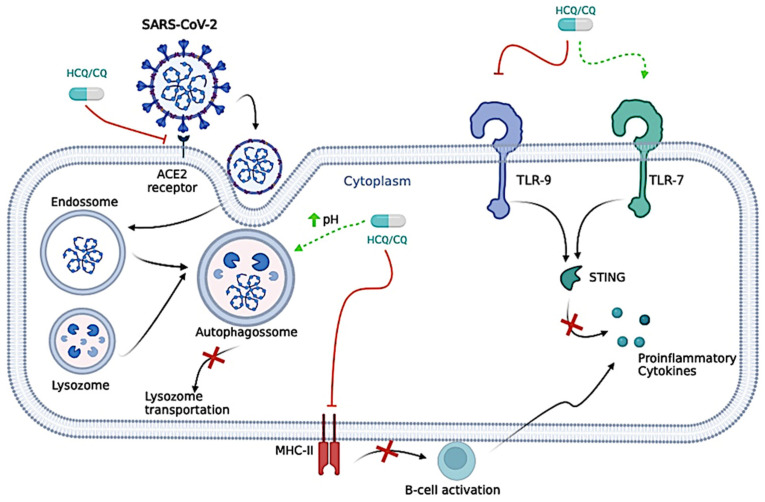Figure 3.
Proposed antiviral mechanisms of Chloroquine/Hydroxychloroquine (CQ/HCQ). CQ/HCQ is responsible for neutralizing the pH of the lysosome, which could prevent vital viral pathways, such as the S protein cleavages, and make it difficult for the virus to enter host cells. CQ/HCQ is also responsible for the inhibition of the lysosomes and autophagosomes, ultimately leading to the blockage of lysosome transportation. CQ/HCQ inhibits the movement of severe acute respiratory syndrome coronavirus 2 (SARS-CoV-2) from early endosomes to early lysosomes, thus further disrupting the release of viral genetic material. CQ/HCQ reduces Angiotensin-Converting Enzyme (ACE)-2 glycosylation, inhibiting this interaction and preventing the virus from binding and integrating into new cells. CQ/HCQ might also interfere in the cytokine storm caused by coronavirus disease (COVID)-19 through several pathways, such as the inhibition of the presentation of antigen by the antigen-presenting cells to T cells, declining the total of T cell activations, the blockage of Toll-Like Receptor (TLR)-9, activation of TLR-7, interfering in the Stimulator of Interferon Gene (STING) pathway—cyclic guanosine monophosphate–adenosine monophosphate (GMP-AMP) synthase, and ultimately decreasing the production of cytokines. The processing of antigens to peptides in Antigen Presenting Cells (APCs) is disrupted by HCQ, which, in turn, disrupts peptide presentation for major histocompatibility complex class II (MHC-II) cells. The disruption caused by HCQ also interferes with B-cell activation by CD4+ (cluster of differentiation 4) T-cells; thus, this diminishes their functions and cytokine production [Interleukin (IL)-1, IL-6, Interferon (INF)-gamma (INF-γ), TNF-alpha (TNF-α), and B-cell activating factor]. The figure was created in BioRender (BioRender.com).

